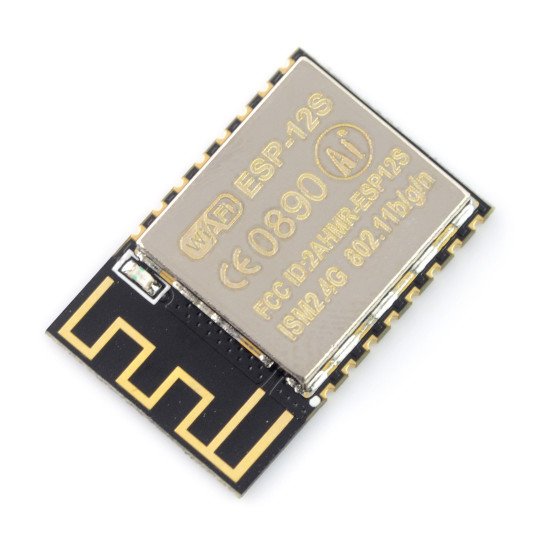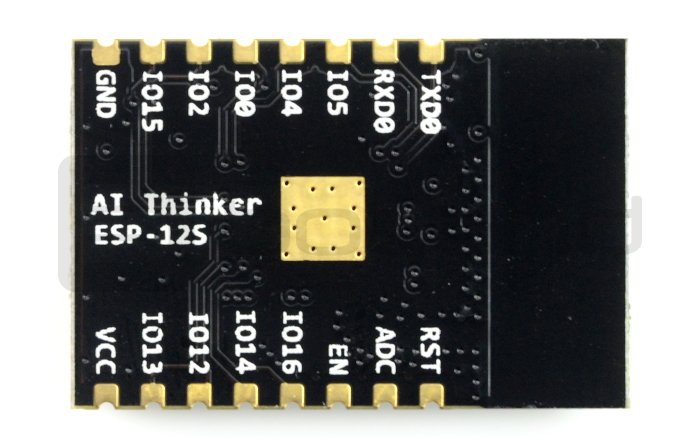Description
Wi-fi module based on the ESP8266 chip. It works in standard wi-fi 802.11 b/g/n at 2.4 GHz. It is equipped with 16 pins - pitch of 2 mm, 9 of which is GPIO, 1 ADC and UART. It has a built-in LED and a PCB antenna. The board size: 24 x 16 mm. The system is compatible with ESP-12E, ESP-12F.
|
Compared tothe previous version of ESP-12E, ESP-12S has less pins and best wi-fi range, thanks to the improved antenna, the whole system is more stable. It differs from the previous version in the absence of pins on the short side of the module.
In our offer, you will also findan adapter that allows you to attach the chip into the breadboard. |
Features of the ESP-12E module
Features that distinguish the ESP-12E module on the background of the whole family of ESP-XX:
- It has 16 pins:
- 9 x GPIO - digital outputs/inputs
- 1 x ADC input - analog-to-digital converter
- 2 x UART (TX, RX) - for communicating, for example with Arduino
- Mounting: SMD / THT:
- Hole diameter: 0.9 mm
- Pins' pitch: 2 mm
- The default transfer rate of UART communication: 115200 bps
- It is equipped with built-in PCB antenna
- Shielded module
- Dimensions: 24 x 16 mm
Connection
The module has 16 pins, pitch of 2 mm.
| Pin | Description |
|---|---|
| TxD | The transmitter of the serial interface UART. |
| RxD | The receiver of the serial interface UART. |
| GPIO x | GPIO pin (digital output/ input) with a serial number. |
| GPIO 0 | GPIO with special function: To update, you need to indicate the low status (connect to GND). |
| GPIO 15 |
GPIO No. 15 with a special function: In normal and programming mode should indicate the low status (conect to GND). |
| ADC | Input of analog-to-digital converter. |
| REST | The system reset. |
|
EN (CH_PD) |
Power down - indication of low status causes a transition to sleep mode.
To update, you need to indicate a high status (3.3 V). |
| VCC | The power supply is 3.3 V. |
|
The product is compatible with Arduino Instruction of connecting the module with Arduino basing on the module ESP-01, you can find on the blog Majsterkowo and in guide prepared by us.
The board tolerates a voltage of 3.3 V. Therefore, you must choose Arduino operating with the voltage of 3.3 V or use a converter.
|
Specification
- Supply voltage: 3.3 V
- Current consumption at rest: approx. 10 µA
- Chip: ESP8266
- Flash memory: 4 MB
- Standard: wi-fi 802.11 b/g/n
- It operates in the 2.4 GHz frequency
- It supports WPA / WPA2 protections
- It can work in AP mode (Access Point), STA mode (standalone) and AP+STA mode
- It supports AT commands
- Communication: UART (Rx, Tx)
- The default UART speed: 115200 bps
- Mounting SMD or THT
- Pins pitch: 2 mm
- Hole diameter: 0.9 mm
- It has 16 pins, pitch of 2 mm
- 9 x GPIO - digital outputs/inputs
- 1 x ADC input - analog-to-digital converter
- Lua software support
- Board sizes: 24 x 16 mm















































































































































































































































































































































